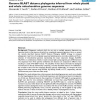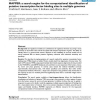291 search results - page 29 / 59 » Progressive multiple sequence alignments from triplets |
IPPS
2008
IEEE
14 years 2 months ago
2008
IEEE
One of the most commonly used tools by computational biologists is some form of sequence alignment. Heuristic alignment algorithms developed for speed and their multiple results s...
BMCBI
2006
13 years 7 months ago
2006
Background: Since the publication of the first draft of the human genome in 2000, bioinformatic data have been accumulating at an overwhelming pace. Currently, more than 3 million...
ECAI
2004
Springer
14 years 1 months ago
2004
Springer
The Hierarchical Hidden Markov Model (HHMM) is a well formalized tool suitable to model complex patterns in long temporal or spatial sequences. Even if effective algorithms are ava...
BMCBI
2006
13 years 7 months ago
2006
Background: Phylogenetic methods which do not rely on multiple sequence alignments are important tools in inferring trees directly from completely sequenced genomes. Here, we exte...
BMCBI
2005
13 years 7 months ago
2005
Background: Cis-regulatory modules are combinations of regulatory elements occurring in close proximity to each other that control the spatial and temporal expression of genes. Th...


